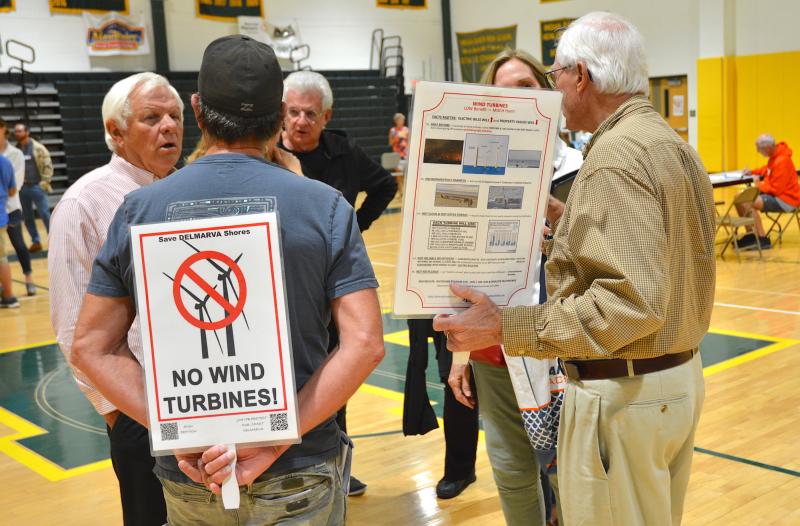Public concerned about BOEM’s public meeting on wind farms

While concerns were raised about viewshed and possible landfall locations for power lines, the biggest concern voiced at an Oct. 27 public meeting about US Wind’s proposed wind farm off Maryland’s coast was about the meeting itself.
US Wind is proposing to install up to 121 turbines in three phases, up to four offshore substation platforms, one meteorological tower and up to four offshore export cable corridors with landfall occurring within Delaware Seashore State Park. The lease area is about 8.7 nautical miles offshore from Maryland and about 9 nautical miles offshore from Sussex County.
The Bureau of Ocean Energy Management announced in late September that it will accept comments on the draft environmental impact statement of US Wind’s construction and operations through Monday, Nov. 20. As part of the 45-day public comment period, BOEM hosted two in-person public meetings – Oct. 24 at Ocean City Elementary and Oct. 26 at Indian River High School in Dagsboro. BOEM also conducted two virtual public hearings.
Hundreds of people attended the meeting at Indian River High School. Most of them questioned the open-house style.
Dave Stevenson, director of Caesar Rodney Institute’s Center for Energy and Environmental Policy, said people attended with the expectation to hear brief presentations with an opportunity to give brief vocal comments.
“People came here to vent and they didn’t get to do that,” said Stevenson.
Standing next to Stevenson was Brad Newcomer, a member of the public who was equally annoyed at the forum, especially after being told he could not hold a sign against the proposed wind farms.
Newcomer said the people from BOEM kept saying it was their meeting, but it wasn’t. The meeting was paid for by the public and it’s the public’s meeting, he said.
There were more than a dozen BOEM experts on hand to answer questions, but official public comment was only accepted in written form or through a court stenographer.
Not everyone was against the meeting style. Delaware Surf Fishing’s Rich King said it allowed BOEM officials to get comments without it turning into a circus.
Lissa Eng, one of a few BOEM communication specialists on hand, acknowledged the frustration, noting there was some miscommunication about how the meeting would be conducted.
As for comments on the proposed wind farms, they tend to center around viewshed and landfall. There was some concern that the visuals being used by BOEM seem to show the turbines larger than the visuals presented by US Wind at other meetings.
John McCarty, a visual impact expert for BOEM, said he didn’t have a concrete explanation for the difference in images used before and the ones on hand at the meeting. Speculating, he said the previous images could have been used with older turbine technology.
“Those turbines are much smaller than they are now,” said McCarty.
BOEM is still in the review process of US Wind’s plan, so McCarty was hesitant to comment. However, he said, he’s been driving around to all the different locations used for the images and he thinks they’re pretty accurate.
In either case, Thomas Maronick, an attorney from Ocean City, described the view as an industrial wasteland that would have devastating effects on the tourism industry. There have not been enough studies done on the turbines, he said.
“If we don’t have the view, we don’t have the tourists,” said Maronick. “This is the first time I’ve had to comment on this and I’m going to do everything in my power to stop it.”
King said BOEM should’ve done a better job explaining that the images were closeups of the wind farms. He said he’s in favor of wind farms because there need to be clean energy sources and people will be able to fish at each turbine.
“Each monopile will be its own reef structure,” said King.
Rehoboth Beach Mayor Stan Mills said he was in attendance to get a look at what Danish developer Ørsted could be bringing to the table. It’s almost the same situation, he said.
Ørsted is working its way through a similar process for a federally regulated wind farm area about 17 miles due east of Delaware.
“We’re not talking about three or four turbines here. There could potentially be hundreds,” said Mills.
Norwood Truitt, Dagsboro town councilman, said he’s concerned about the visuals and the potential landfall areas. The project doesn’t really seem to benefit Delaware, he said.
“The impact on Dagsboro isn’t much, but there are concerns about it connecting in our town,” said Truitt.
Chris Flood has been working for the Cape Gazette since early 2014. He currently covers Rehoboth Beach and Henlopen Acres, but has also covered Dewey Beach and the state government. He covers environmental stories, business stories, random stories on subjects he finds interesting and has a column called ‘Choppin’ Wood’ that runs every other week. Additionally, Chris moonlights as the company’s circulation manager, which primarily means fixing boxes during daylight hours that are jammed with coins, but sometimes means delivering papers in the middle of the night. He’s a graduate of the University of Maine and the Landing School of Boat Building & Design.
























































